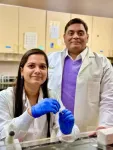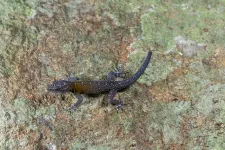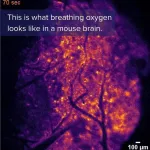(Press-News.org) Waltham — March 28, 2024 — For patients considering or undergoing plastic and reconstructive surgery (PRS) procedures, using social media to gather information and answer questions can enhance patient empowerment – potentially leading to increased autonomy and better decision-making, reports a study in the April issue of Plastic and Reconstructive Surgery®, the official medical journal of the American Society of Plastic Surgeons (ASPS). The journal is published in the Lippincott portfolio by Wolters Kluwer.
"Our study suggests that connecting to social media is associated with meaningful increases in empowerment for PRS patients, and may have positive effects on patient-centered decision-making," comments ASPS Member Surgeon Samuel J. Lin, MD, MBA, of Beth Israel Deaconess Medical Center and Harvard Medical School, Boston.
Social media use linked to higher empowerment scores
The researchers performed an online survey using Amazon's Mechanical Turk crowdsourcing platform. Of 473 respondents, about 70% had undergone some type of PRS: cosmetic in 40%, reconstructive in 23%, and both cosmetic and reconstructive in eight percent. A modified version of the Cyber Info-Decisional Empowerment Scale (CIDES) was used to explore assoiciations between social media and patient empowerment.
About three-fourths of patients reported seeking plastic surgery information online at some time during their PRS experience. Depending on the resources used, patients who obtained information online had higher scores for patient empowerment.
In particular, social media users scored higher on six out of seven CIDES categories: patient knowledge; the decision to consult with a plastic surgeon and questions during the consultation; and treatment decision-making, awareness of treatment decisions, and awareness of other treatment options.
Compared to those using other social media platforms, Facebook users had higher scores in certain categories: decision to consult, questions during consultation, and awareness of other treatment options. RealSelf, a plastic surgery-focused platform, was also associated with increased empowerment in treatment options.
Plastic surgeons urged to 'engage with and contribute to' social media
Social media use had a greater impact on empowerment for patients undergoing cosmetic breast surgery, and for reconstructive procedures on the abdomen/trunk or hand. Most patients said that they received helpful information from their plastic surgeon's office, although some found this information difficult to read.
"As medical care shifts toward a model of patient-centered decision-making, it's important to understand how online information, and social media in particular, affects patient empowerment," says Dr. Lin. "Our findings suggest that social media can be a useful tool to promote patient autonomy and decision-making among patients considering PRS procedures." Previous studies suggest that patient empowerment is associated with improved healthcare experiences and outcomes.
Social media platforms such as Facebook and RealSelf offer a "forum-like interface" for patients to post questions and read opinions from other patients and physicians, providing a "sense of community or connection." Dr. Lin adds: "Plastic surgeons can contribute to patient empowerment by engaging with and contributing to social media platforms, providing information based on evidence-based care, and ensuring that the information provided by their office is readable and understandable."
Read Article: Which groups of plastic surgery patients are impacted by social media use: An in-depth review of social media engagement
Wolters Kluwer provides trusted clinical technology and evidence-based solutions that engage clinicians, patients, researchers and students in effective decision-making and outcomes across healthcare. We support clinical effectiveness, learning and research, clinical surveillance and compliance, as well as data solutions. For more information about our solutions, visit https://www.wolterskluwer.com/en/health.
###
About Wolters Kluwer
Wolters Kluwer (EURONEXT: WKL) is a global leader in information, software solutions and services for professionals in healthcare; tax and accounting; financial and corporate compliance; legal and regulatory; corporate performance and ESG. We help our customers make critical decisions every day by providing expert solutions that combine deep domain knowledge with technology and services.
Wolters Kluwer reported 2023 annual revenues of €5.6 billion. The group serves customers in over 180 countries, maintains operations in over 40 countries, and employs approximately 21,400 people worldwide. The company is headquartered in Alphen aan den Rijn, the Netherlands.
For more information, visit www.wolterskluwer.com, follow us on LinkedIn, Facebook, YouTube and Instagram.
END
Social media use may help to empower plastic surgery patients
Survey suggests positive effects on patient decision-making, reports Plastic and Reconstructive Surgery®
2024-03-28
ELSE PRESS RELEASES FROM THIS DATE:
Q&A: How to train AI when you don't have enough data
2024-03-28
Artificial intelligence excels at sorting through information and detecting patterns or trends. But these machine learning algorithms need to be trained with large amounts of data first.
As researchers explore potential applications for AI, they have found scenarios where AI could be really useful — such as analyzing X-ray image data to look for evidence of rare conditions or detecting a rare fish species caught on a commercial fishing boat — but there's not enough data to accurately train the algorithms.
Jenq-Neng Hwang, University of Washington professor of electrical and computer and engineering, specializes in these issues. ...
Wayne State University researchers uncover potential treatment targets for Zika virus-related eye abnormalities
2024-03-28
DETROIT - A groundbreaking study published in the journal iScience presents crucial insights into the ocular effects of Zika virus infection during pregnancy and offers promising avenues for therapeutic intervention.
Produced by a team of researchers in the Department of Ophthalmology, Visual and Anatomical Sciences at the Wayne State University School of Medicine, the paper, “Targeting ABCG1 and SREBP-2 mediated cholesterol homeostasis ameliorates Zika virus-induced ocular pathology,” provides compelling evidence of the ...
Discovering Van Gogh in the wild: scientists unveil a new gecko species
2024-03-28
You’ve probably seen nature depicted in art, but how often do you see an artwork hiding in nature?
When they saw the back of a lizard in the Southern Western Ghats, a group of scientists from the Thackeray Wildlife Foundation in India were reminded of Van Gogh’s The Starry Night. As soon as they figured out it was a new species, it was only apt to name it in honour of the famous painter.
“Cnemaspis vangoghi is named for Dutch painter Vincent Van Gogh (1853–1890) as the striking colouration of the new species is reminiscent of one of his most iconic paintings, The ...
Small birds spice up the already diverse diet of spotted hyenas in Namibia
2024-03-28
Hyenas are generalist predators (and scavengers) with a broad range of prey species. They are known for hunting (or scavenging) larger mammals such as antelopes and occasionally feed on smaller mammals and reptiles. Being flexible in the choice of prey is a strategy of generalists – and this even extends to small passerine birds, as scientists from the Leibniz Institute for Zoo and Wildlife Research (Leibniz-IZW) and the University of Ljubljana observed in Namibia: Spotted hyenas pursued red-billed queleas, picked them from the ground or the surface of a waterhole and swallowed them whole, at a success rate of approximately one bird every three minutes. These observations were described ...
Imaging detects transient “hypoxic pockets” in the mouse brain
2024-03-28
Using a bioluminescent oxygen indicator, Felix Beinlich and colleagues discovered a spontaneous, spatially defined occurrence of “hypoxic pockets” in the mouse brain. Their technique offers a way to learn more about brain oxygen tension (pO2), a measure of oxygen delivery and demand in brain tissue that changes dynamically but is not well understood. The findings could have implications for how rest and exercise affect pO2 in the human brain, including the role of these activities in conditions such as dementia, Beinlich et al. suggest. The researchers used a genetically encoded bioluminescent oxygen indicator called Green NanoLuc in mouse cortical astrocytes to ...
Dissolved organic matter could be used to track and improve the health of freshwaters
2024-03-28
The dissolved organic matter (DOM) from hundreds of plant and animal remains could be used to track and possibly restore the health of freshwater bodies, Andrew J. Tanentzap and Jérémy A. Fonvielle write in this Perspective. The broad range of compounds, or chemodiversity, of DOM has multiple effects in freshwaters, including providing nutrients to support food web productivity, reducing or enhancing contamination from pollutants, and influencing the metabolism of microorganisms important to the biogeochemical cycle. DOM may also reduce the heat that ...
Indoor air quality standards in public buildings would boost health and economy, say international experts
2024-03-28
There should be mandatory indoor air quality standards, say an international group of experts led by Professor Lidia Morawska.
Professor Morawska, Vice-Chancellor Fellow at the University of Surrey and Distinguished Professor at Queensland University of Technology, led the appeal to the World Health Organization to recognise the airborne transmission of the virus which causes COVID-19 early in the pandemic – and help minimise it.
Now, in a paper published by the prestigious journal Science, Professor Morawska's international team recommends setting standards for ventilation rate and three key indoor pollutants: carbon ...
Positive associations between premenstrual disorders and perinatal depression
2024-03-28
Women affected by premenstrual disorders have a higher risk of perinatal depression compared with those who do not, according to research published March 28th in the open access journal PLOS Medicine. The relationship works both ways: those with perinatal depression are also more likely to develop premenstrual disorders after pregnancy and childbirth. This study suggests that a common mechanism might contribute to the two conditions.
Menstruating women experience cyclical hormone fluctuations through puberty, menstrual cycle, pregnancy ...
New imaging method illuminates oxygen's journey in the brain
2024-03-28
The human brain consumes vast amounts of energy, which is almost exclusively generated from a form of metabolism that requires oxygen. Consequently, the efficient and timely allocation and delivery of oxygen is critical to healthy brain function, however, the precise mechanics of this process have largely remained hidden from scientists.
A new bioluminescence imaging technique, described today in the journal Science, has created highly detailed, and visually striking, images of the movement ...
Researchers discover key gene for toxic alkaloid in barley
2024-03-28
All plants mediate their environmental interactions via chemical signals. An example is the alkaloid gramine produced by barley, one of the world’s most widely grown cereals. Gramine provides protection against herbivorous insects and grazing animals and inhibits the growth of other plants. Despite long-standing interest, the key gene for the formation of gramine remained elusive.
The researchers discovered a cluster of two genes in barley for gramine biosynthesis. The first gene (HvNMT) had already been discovered 18 years ago. In their study the researchers from IPK and the Leibniz University Hannover now identified a second gene (AMI synthase, HvAMIS), and ...
LAST 30 PRESS RELEASES:
How to make AI truly scalable and reliable for real-time traffic assignment?
Beyond fragmented markets: A new framework for efficient and stable ride-pooling
Can shape priors make road perception more reliable for autonomous driving?
AI tracks nearly 100 years of aging research, revealing key trends and gaps
Innovative techniques enable Italy’s first imaging of individual trapped atoms
KIER successfully develops Korea-made “calibration thermoelectric module” for measuring thermoelectric device performance
Diversifying US Midwest farming for stability and resilience
Emphasizing immigrants’ deservingness shifts attitudes
Japanese eels, climate change, and river temperature
Pusan National University researchers discover faster, smarter heat treatment for lightweight magnesium metals
China’s 2024 Gastroenterology Report: marked progress in endoscopy quality and disease management
Pusan National University researchers uncover scalable method for ultrahigh-resolution quantum dot displays
Researchers use robotics to find potential new antibiotic among hundreds of metal complexes
Gut bacteria changes at the earliest stages of inflammatory bowel disease
Scientists develop new way to “listen in” on the brain’s hidden language
Brain research: “Pulse generators” grow and shrink as memories are formed
For teens, any cannabis use may have impact on emotional health, academic performance
School meals could unlock major gains for human and planetary health
Menopause hormone therapy does not appear to impact dementia risk
Signature patterns of brain activity may help predict recovery from traumatic brain injury
Dresden study uncovers new key mechanism in cancer cells
New species are now being discovered faster than ever before, study suggests
Cannabis-based products show limited short-term benefit for chronic pain, with increased risk of adverse effects
Cannabis products with more THC slightly reduce pain but cause more side effects
Clearing the brain of aging cells could aid epilepsy and reduce seizures
Brain injuries linked with potential risk of suicide, new study finds
New technique lights up where drugs go in the body, cell by cell
New study finds movement of fishing fleets can reveal shifts in marine ecosystems
Embargoed: New evidence points to potential treatment for vascular dementia
Study uncovers disrupted brain balance in alcohol dependence
[Press-News.org] Social media use may help to empower plastic surgery patientsSurvey suggests positive effects on patient decision-making, reports Plastic and Reconstructive Surgery®




